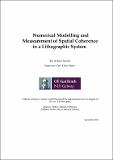Numerical Modelling and Measurement of Spatial Coherence in a Lithographic System

View/
Date
2011-09-30Author
Smith, Arlene
Metadata
Show full item recordUsage
This item's downloads: 3306 (view details)
Abstract
For the last five decades, optical lithography has been used universally for the manufacture of integrated circuits. The drive towards smaller circuit feature size, and the
resulting increase in resolution of lithography systems, has been achieved by changing
the source type. The original 300 - 400 nm discharge lamps have been replaced
with more powerful and monochromatic excimer lasers, operating at user-selectable
Ultra-Violet (UV) wavelengths from 157 - 351 nm. The success of UV lithography
is due, in part, to the development of industrialized, line narrowed excimer lasers.
However, the line narrowing process, along with the intrinsic coherence properties of
the laser, results in a source with a considerable amount of spatial coherence. These
partially coherent sources are complicated to model. Partially coherent image formation
with two-dimensional intensity fields requires evaluating four-dimensional integrals. Thus calculations are complex, slow to process and place demands on system
memory. The motivation behind this thesis is an improved understanding of the
effects of spatial coherence in optical lithography, including beam homogenization in
wafer-stepper systems. In this thesis, we expand the Elementary Function Method, a
process similar to coherent mode decomposition, to develop a numerical model of a
partially spatially coherent source. We design an experiment to measure the spatial
coherence of a partially coherent laser source and present our results. The numerical
model is tested on a theoretical Gaussian Schell-model source, and then applied to
the excimer source. We examine the traditional method for beam conditioning, the
imaging homogenizer, and develop a model of the physical process involved in beam
homogenization. Our results show that the imaging homogenizer is designed for use
with spatially incoherent sources, where it performs well. However, if the source incident
on the homogenizer has any degree of spatial coherence, the intensity output is highly non-uniform.

